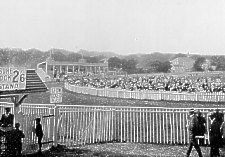Racecourses
The first racecourse noted was that instituted by James VIIth earl
of Derby who organised races on a piece of land extending rather more
than a mile across the peninsula of Langness - a description
of one of these in 1687 was entered at the Rolls Office. Land at
Langness continued to be known
as the racecourse though it would seem that races were athletics
rather than horse-racing.
There were horse
races at Peel and Douglas from 1811 though they seemed to have
ceased after 1815.
John Welch in his often acerbic guide
of 1836, suggested that Port-y-chree meadow would make a good
course:
The meadow of Port-y-chee is well adapted
for a race-course, and, from its vicinity to Douglas, will
probably be used as such by and bye, when some sporting character
of sufficient wealth and influence shall give the start to such an
amusement.
However no note seems to have been taken.
Strang
The next racecourse was one established at the Strang, adjacent to
the newly opened Lunatic Asylum,( probably on
the same field as one-time used for the Strang Fair in the early 19th
century), which was opened on Thursday and Friday, July 14 and 15,
1870. Considerably more than £1000 was
given in prize money but, according to a 1888 IoMSPCo guide, was very
far from being recouped from all sources (admission to ground and
grandstand). "The second attempt was even a more signal failure,
occasioning the meetings to be discontinued." Jenkinson's guide of
1875 has the following description:
The Race Course is situated on rising
ground, commanding a beautiful view. In the direction of the
Asylum are seen parts of Douglas, the hotel
on the Head, and a strip of the sea ;
and then the table-land runs past the Carnane Hill, Mount Murray,
and Slieu Chiarn, away to South Barrule and Slieu Whallin. In the
opposite direction are Greeba, Slieu Reay, Colden, Carraghan,
Pen-y-Pot, Snaefell, and the Cairn; a grand mountain array, viewed
with wonder from this favourable standpoint, by the numbers who
yearly assembled here to enjoy the national sport.
The Race Course was opened in July, 1870, and
is formed with a ring fence of 70 acres, and has been constructed
at considerable expense, with two grand stands, capable of holding
a thousand people each, with refreshment rooms, &c. The races
took place in the month of August every year, lasting two days.
About 10001. of added money was given, and the meeting
appeared gradually becoming one of the best in the United Kingdom.
During the race days the railway company ran special trains to a
temporary station between Kirk Braddan and Union Mills, and within
a short distance of the course. The races not having been found to
pay, they have been discontinued, and the course is occasionally
used by the Bicycle Club.
The temporary halt was however erected in 1873, so it would appear
that races were at least planned for 1873; according to Boyd the
contractors Watson & Smith wanted £166 8s 0d for building it
whilst the railway company claimed that £71 10s 0d had been
agreed.
Bellevue
A more successful venture was established at Bellevue, now the
site of the National Sports Centre but which had been laid out in
1889 as an athletics ground and then used in 1892 for the IoM
International Exhibition.
 The course opened in 1912 and was a popular attraction - though
according to Stenning 'Racing degenerated to such low esteem that the
Course was closed and later became a Municipal Sports Ground' -the
course closed in 1931. when Tynwald made on course betting
illegal.
The course opened in 1912 and was a popular attraction - though
according to Stenning 'Racing degenerated to such low esteem that the
Course was closed and later became a Municipal Sports Ground' -the
course closed in 1931. when Tynwald made on course betting
illegal.
References
J.C.Boyd The IoM Railway vol1 Oakwood Press 1993 (p68)
|
|

|
|
|
|
|
Any comments, errors or omissions
gratefully received The
Editor
©
F.Coakley , 2000
|
 The course opened in 1912 and was a popular attraction - though
according to Stenning 'Racing degenerated to such low esteem that the
Course was closed and later became a Municipal Sports Ground' -the
course closed in 1931. when Tynwald made on course betting
illegal.
The course opened in 1912 and was a popular attraction - though
according to Stenning 'Racing degenerated to such low esteem that the
Course was closed and later became a Municipal Sports Ground' -the
course closed in 1931. when Tynwald made on course betting
illegal.